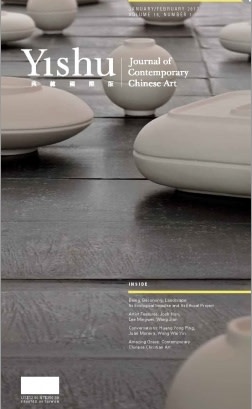Nothingness was not, the existent was not;
Darkness was hidden by darkness . . .
There was neither death nor immortality then;
no distinguishing sign of night nor of day;
That which became was enveloped by the Void1
In his text supporting the Wang Jian exhibition, nothingness was not 无非物 (October 15–18 December 18, 2016), at Pifo Gallery, Beijing, curator Adrian George foregrounded the above verse from the Rigveda (1500–2000 B. C.), a collection of Vedic sanskrit hymns, and its reference to nothingness and the void, which in his view were made manifest by the artist’s drawings, paintings, and photographs. The theme of nothingness and void seems to reflect a current zeitgeist in China, expressing the sentiment of a cultural and historic wound such as the Cultural Revolution that has not only not been healed, but the horrors of brutality and suffering of that period have not even been fully acknowledged. This memory remains embedded in the minds of many individuals and their families who are still alive today. Such topical events across the Chinese art world include Wang Shilong’s work on the cultural wound “. . . a memory of pain and the inability to fully heal,”2 earlier in 2016 at Pifo Gallery’s exhibition, Poetique: The 9th Annual Exhibition of Abstract Art. At the Whitechapel Gallery, London, Making the New World: The Arts of China’s Cultural Revolution was a conference held in November 2016, in which speakers were invited to reassess the significance of the arts and culture of the Cultural Revolution, and their subsequent impact on everyday life in China.
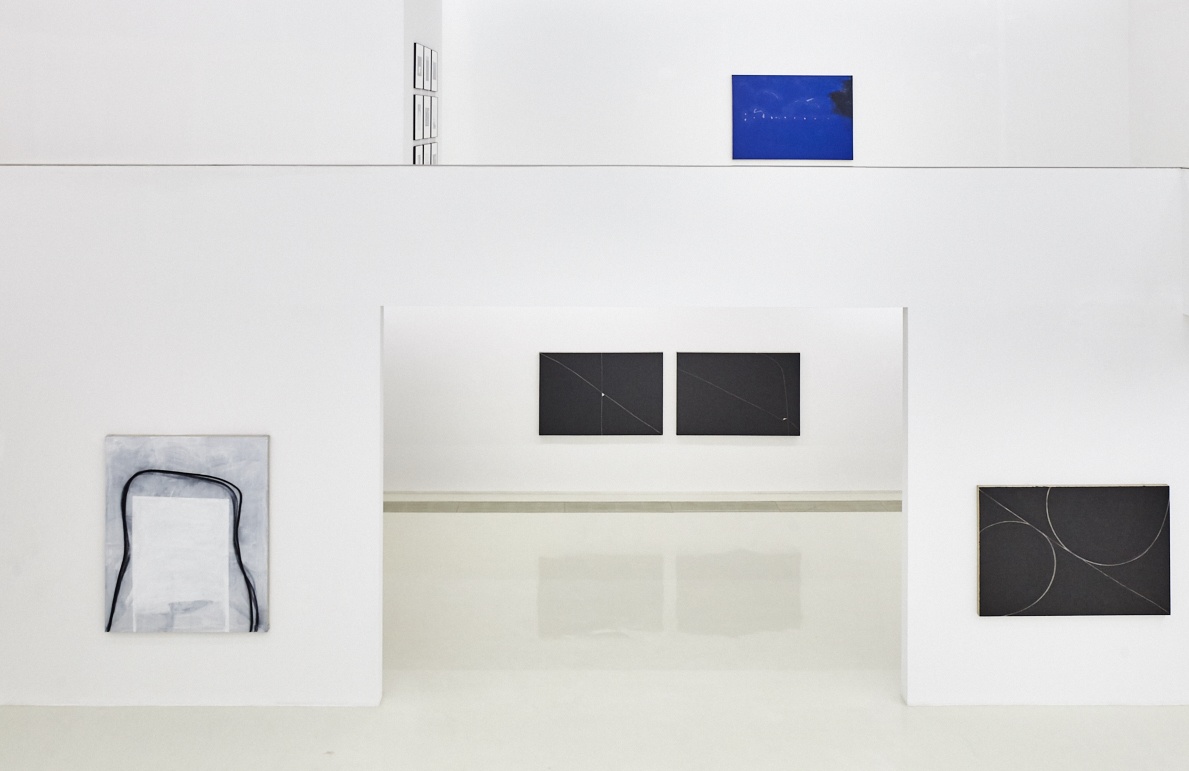
Wang Jian, nothingness was not, 2016, installation view at PIFO Gallery. Photo: Lv Wenzhi.
Wang Jian, born in 1972, Handan, Hebei province, belongs to a generation who were brought up in the tumultuous years of the Cultural Revolution, where they were surrounded by hardship, hopelessness, jealousy, treachery, and injustice. This generation is caught in a web of ambivalence, trying to make sense of their parents’ anguish and memories, and their own ostensibly more privileged life with its attendant spiritual complacency. The price to pay is a disconnection from society that is probably unnervingly reflected back at them in the architecture of their new habitats, of modern indifferent facades characterized by hard concrete, rigid steel, and icy cold glass.
The title nothingness was not takes the first line of the Rigveda, setting up a dialectic between nothingness, its negation, and the void. Is the exhibition meant to be a philosophical entreaty about nothingness—its existence or non-existence—and is nothingness enveloped by the void? I am immediately impelled and guided by the title to recall the famous If Not, Not (1975–76), by R. B. Kitaj, although no doubt I run the peril of being accused of legitimizing contemporary Chinese art through a Western counterpart. Regardless, the aesthetic of the void and its contemporaneous representation in art by Chinese artists would not have been coincidental to the teleology of globalization.
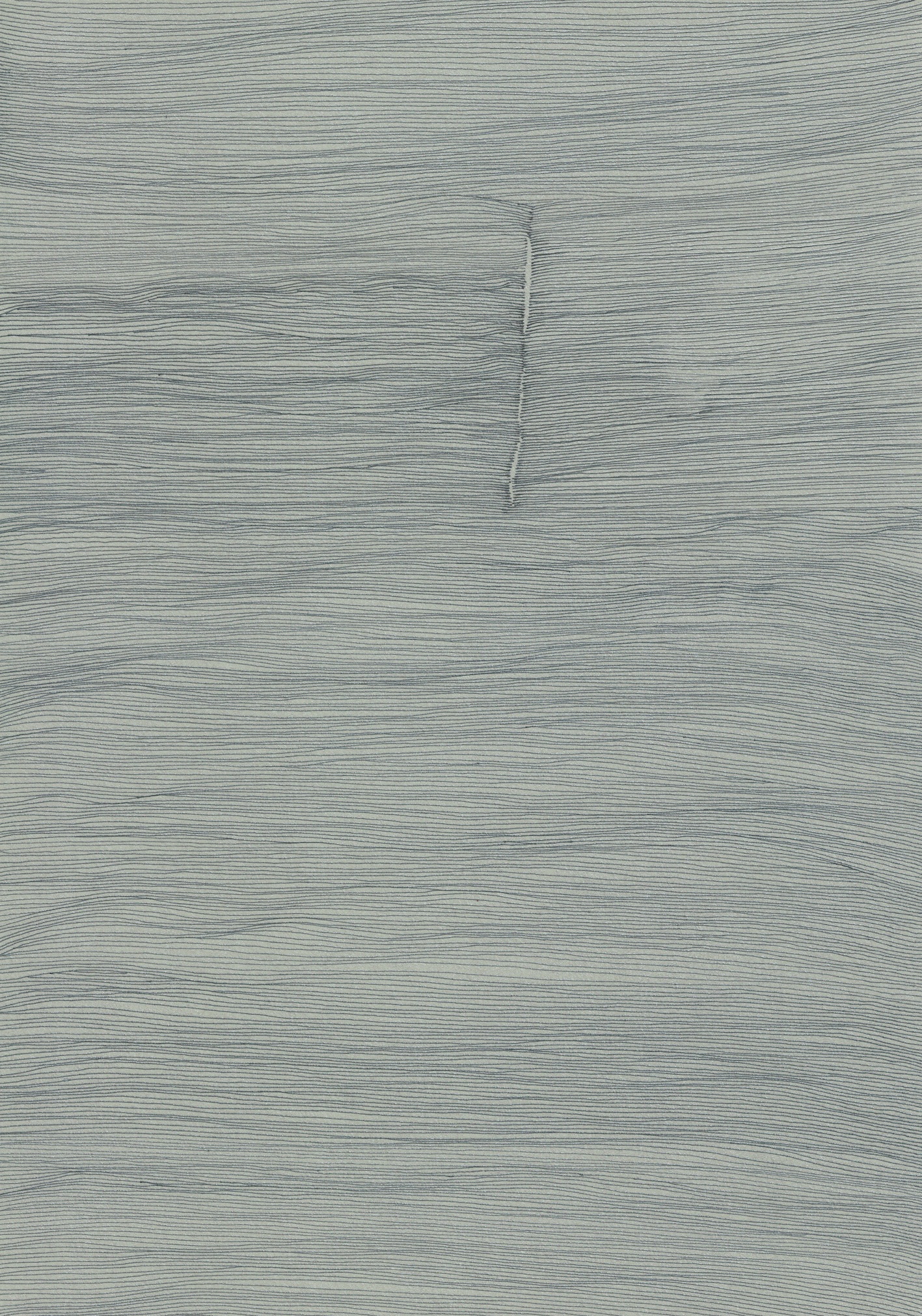 Wang Shilong, No. 84, 2009, silverpoint on paper, 29.5 x 21 cm.
Wang Shilong, No. 84, 2009, silverpoint on paper, 29.5 x 21 cm.
Kitaj’s If Not, Not, is a figurative rather than abstract painting but the sentiment expressed would seem to stem from similar motivations arising from cultural disintegration and disillusionment. It too has been inspired by a poem, T. S. Eliot’s, The Waste Land.3 At first glance, Kitaj’s colourful painting seems permeated with life, of palm trees and fecund water beneath fiery skies, an almost paradisiac evocation, in complete antagonism to the poem.
This stony rubbish . . .
A heap of broken images, where the sun beats
And the dead tree gives no shelter, the cricket no relief
And the dry stone no sound of water . . .4
Closer inspection, however, exposes the disintegration of the composition of If Not, Not into disparate and incoherent fragments, bringing us closer to a sense of a wasteland, or, indeed, Joseph Conrad’s 1902 novel Heart of Darkness; Kitaj acknowledged both Eliot and Conrad as inspiration for this work. The building in the top left corner of the painting is the gatehouse to Auschwitz. Despite the painting’s vibrancy, Kitaj managed to convey a sense of stillness, of “death and destruction.”5 What clearer message of hopelessness and dystopic nihilism than to feature the idea of the wasteland, with Auschwitz prominently referenced, denoting hell on earth. The Jewish Chronicle Online writes that “If Not, Not, shows a paradise corrupted by horror.”6
The title of Kitaj’s painting was in fact borrowed from a 1968 book by historian Ralph E. Giesey’s, If Not, Not.7 The words are part of an oath that the people of the Aragon region of Spain were supposed to have uttered when they received their king: “We, who are worth as much as you, take you as our king, provided that you preserve our laws and liberties, and if not, not.”8 These words seem to imply choice and hope, ultimatum even. If you do this for us, then we will crown you king. If not, then you will not be our King. That’s quite straightforward. Wang Jian’s title, nothingness was not, on the other hand, is less so. The emphasis seems to verify the first part of the title, “nothingness,” portending the disillusionment of life for many in China today. The Rigveda speaks of being “enveloped by the void.”
In fact, the problematic inherent in language is highlighted by George, which in his view is “unable to successfully (or even adequately) articulate a metaphysical conundrum such as the Void.”9 This in fact brings to our attention the translation of nothingness was not to the Chinese phrase of “无非物” that is also included in the title of the exhibition. The literal translation of “无非物,” is “there-is-only-this-and-nothing-else-thing”— “thing” or “object” being the meaning of “物,” as in “无非物.” This means "无非物” is a thing that exists in its own right, in its own space, independent, almost in isolation, floating in free space. “Nothing-else” categorically denies anything else exists, while conversely proclaiming its own existence.

R. B. Kitaj, If Not, Not, 1975–76, oil on canvas, 152.4 x 152.4 cm. Collection of National Gallery of Modern Art, Edinburgh.
The English part of the title, nothingness was not, however, seems to imply there is something that it is not of, hence something else exists, or at least existed previously and now not, and “nothingness” itself is/was possibly subordinate to it. It also lends itself to imply that “nothingness” is possibly seeking to be what it is not—a longing or craving for something, the possibility of something. Paradoxically, there is nothing in a void, but everything in longing.
Moving on from language and semantics, images also carry their own baggage and are in no way a subordinate means of expression. As Gaston Bachelard wrote in The Poetics of Space, images “demand(s) , . . to be lived directly . . . When the image is new, the world is new.”10 The idea of nothingness forms the source and nadir of Wang Jian’s inspiration. Adrian George also urged the audience to surrender to the image, to the sensorial, and just to experience the artwork—“place yourself squarely in front of it and let go.”11 For some, the abstract “. . . works on the viewer very quickly: the combination of colour, form, and composition provokes an almost instinctive, instant response. . . .”12 For others, the nature of abstraction is that it has the potential to be impenetrable. This tenaciousness and expansiveness carry with it the capacity for an artist to express the inexpressible and the indescribable, for Wang Jian to feel perhaps the unfeelable and speak the unspeakable. Just as Conrad’s Heart of Darkness is interpreted by some to intuit the indiscernible gap between civility and barbarity, so Wang Jian is looking for the elusive meaning that resides in the void, the “nothingness,” or what the nothingness was not.
Driven by ambivalence and skepticism, Wang Jian is, through his artwork, resolutely scrutinizing reality in order to explore a sensibility of chaos, futility, and, possibly, given the bleak title, the meaninglessness of life. He invests in a deliberate intensity of the void that seems to obviate from Kitaj’s insouciant burst of colourful energy. Whereas Kitaj’s If Not, Not is almost a literal evocation of hopelessness shrouded with hope, or hope thwarted by hopelessness, Wang Jian’s abstraction seems to challenge the meaning of life—its entrapments, choices, opportunities, and inequalities. His monochromatic works divest themselves of colour, as if in an act of cleansing, to purge the hopelessness and disillusionment of hope, even amid his quest to make sense. Kitaj’s If Not, Not emblematizes the wasteland, a disparate overlay of desert and paradise, of life and of death, among the debris and the inferno, whereas Wang Jian’s paintings, for example, Huantie H3 (2016), on the other hand, drained of colour and containing only a few lines, as opposed to profiting from a nod to traditional Chinese landscape painting, nevertheless exudes an equally cold disaffection with life that is as destructive as it is defensive (huantie in Chinese means an iron hoop, and can also mean an iron weapon.)
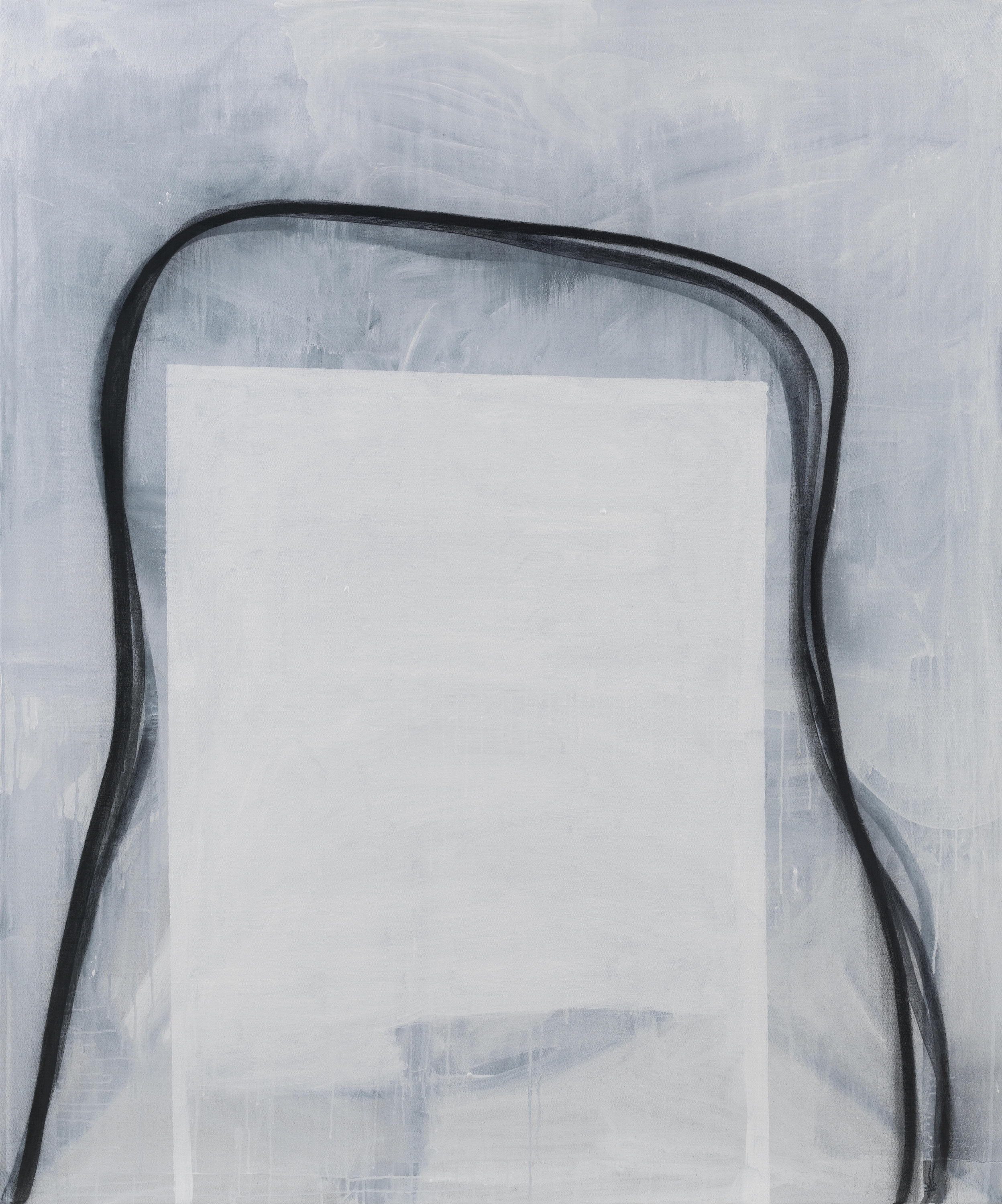
Wang Jian, Huantie H3, 2016, acrylic, charcoal on canvas, 180 x 150 cm.
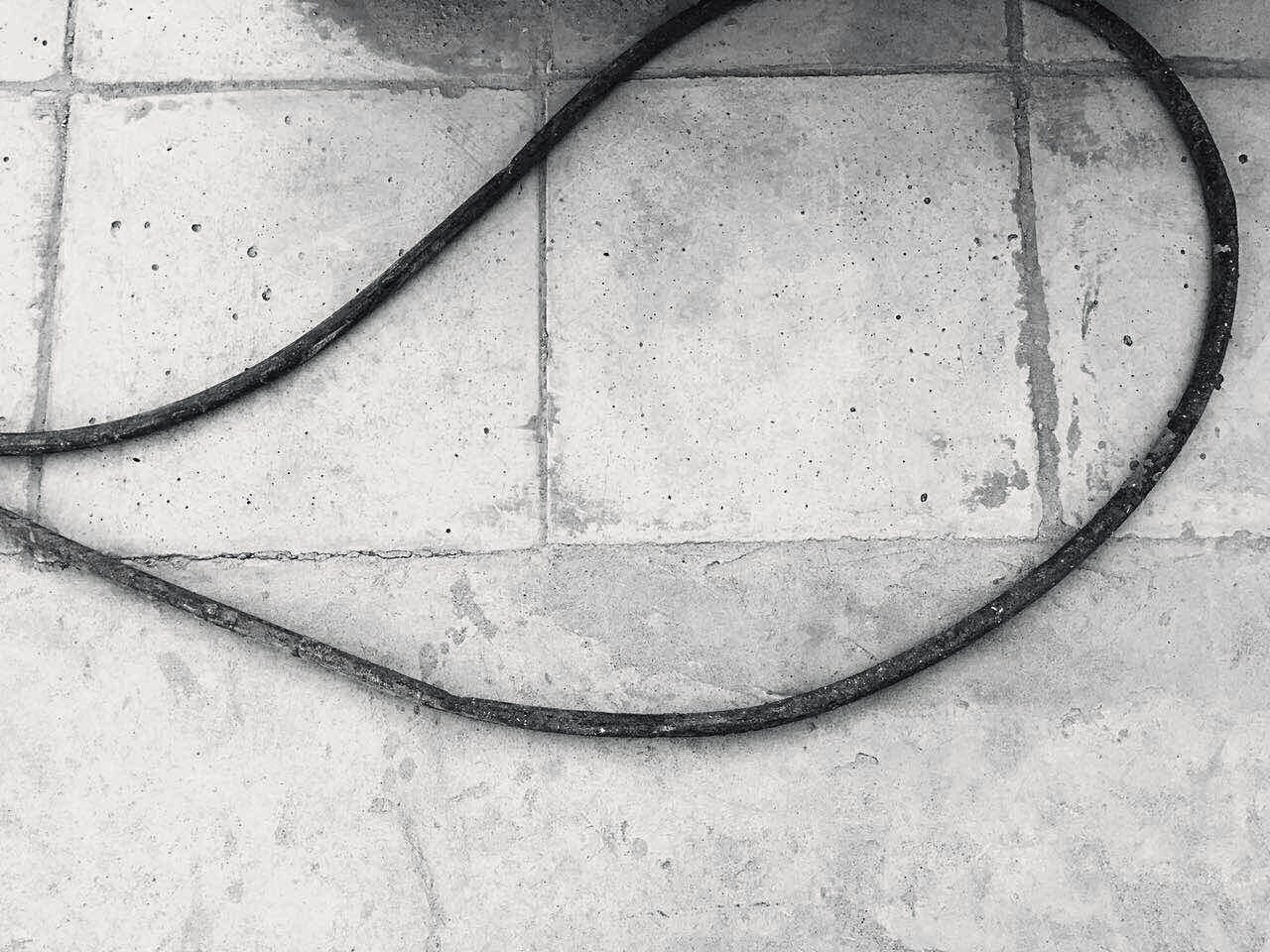
Wang Jian, Jiangnan S1, 2015, Giclée print, 22.5 x 30 cm.
Whereas Kitaj brought stillness to a feverish composition, conversely, the seemingly simplistic monochromatic and spare qualities of Huantie H3 do not discount the sense of a complex multitudinous feeling of inviolacy that Wang Jian has brought to the void. Huantie H3 acknowledges a debt to the photographic original, Jiangnan S1 (2015), a semi abstract form on a journey to becoming a fully abstract composition. In the photograph, we see a coil of rope or thick wire abandoned on the pavement. It is as if a plumb line has been bent and twisted to signify a hangman’s noose. There is a stark difference in the mood between the original photograph and the final painting, the photograph being solid, flat, and its image unyielding. Within the composition of the painting there is a propensity for spatial ambiguity; it has depth, suggesting a three dimensional space, with lines in collision against flat spaces. While still evoking a black rope-like metallic coil, twisting itself resolutely on a white impasto ground, it also suggests voids, ravines, precipices, thus demonstrating the immensity of space.13 Huantie H3 embodies the journey that arises from the realities of the world that are captured in the photograph, and Wang Jian shares with us what exists for him. This painting traces a process of using reality to represent unreality, and bears the potential to transport someone in the right frame of mind to another world, a dream world.14 Perhaps it is a glimpse of something not normally perceived, but captured by the artistic eye during moments of intense observation, part of the “unseen world” that “belongs to the world that lies, visibly, about us. They are unseen merely because they are not perceived. . . .”15 By translating a photograph into a painting, the continuum from the real to the photographic and its omnipotence is expurgated, one—Jiangnan S1, the photograph—may be more categorical, denoting life or life and death . . . another—Huantie H3, the painting—is of discovery, of trying to make sense of life by probing the void, perhaps the spiritual, the repository of lost social continuum, lost faith, lost dreams.
For Wang Jian, the light and the dark of a photograph signify “everything and nothing,”16 just as a void can be something but also nothing. He draws inspiration from everyday life, observing the quotidian spaces that contain their own resonances, residing in the spaces in-between. He looks for shadows and reflections in spaces to denote a sense of absence and/or loss, such as the feeling of melancholia and desolation that come with his photographs of empty hospital beds and empty chairs.17 For example, the single photographic image of a corridor in Jinze S1, with five doors leading from it and forming black spaces against a white background, stands in as a transitory or in-between place, “some place that is neither here nor there, that contains something and nothing. . . . It is a place one passes through in order to get to somewhere else.”18
Jinze H6 津泽 (2016), the charcoal and acrylic version of Jinze S1, is concerned with the expansion of the forms of a photograph into a real imaginative space. Wang Jian’s attraction to photography is not merely confined to its ability for instantaneous compositional and radical cropping, but, as Adrian George emphasized, also to photography’s myriad possibilities of “contrasts,” and blurring of “boundaries,” a sense of “emptiness,” “absence,” or “erasure.”19 Wang Jian uses photography as a pragmatic rather than political tool that allows him to capture the actuality of his everyday life, to enable the supernatural quality of the photographic image, as if it has been ascribed with the magical power of being able to steal someone’s soul.20 Paradoxically, photography anchors Wang Jian to a sense of the real while allowing him to explore its propensity for ambiguity and mysticism. This is a vital component in the process of trying to articulate his preoccupation with the liminal, the edges, the in-between spaces that he imagines to be manifestations of the void.
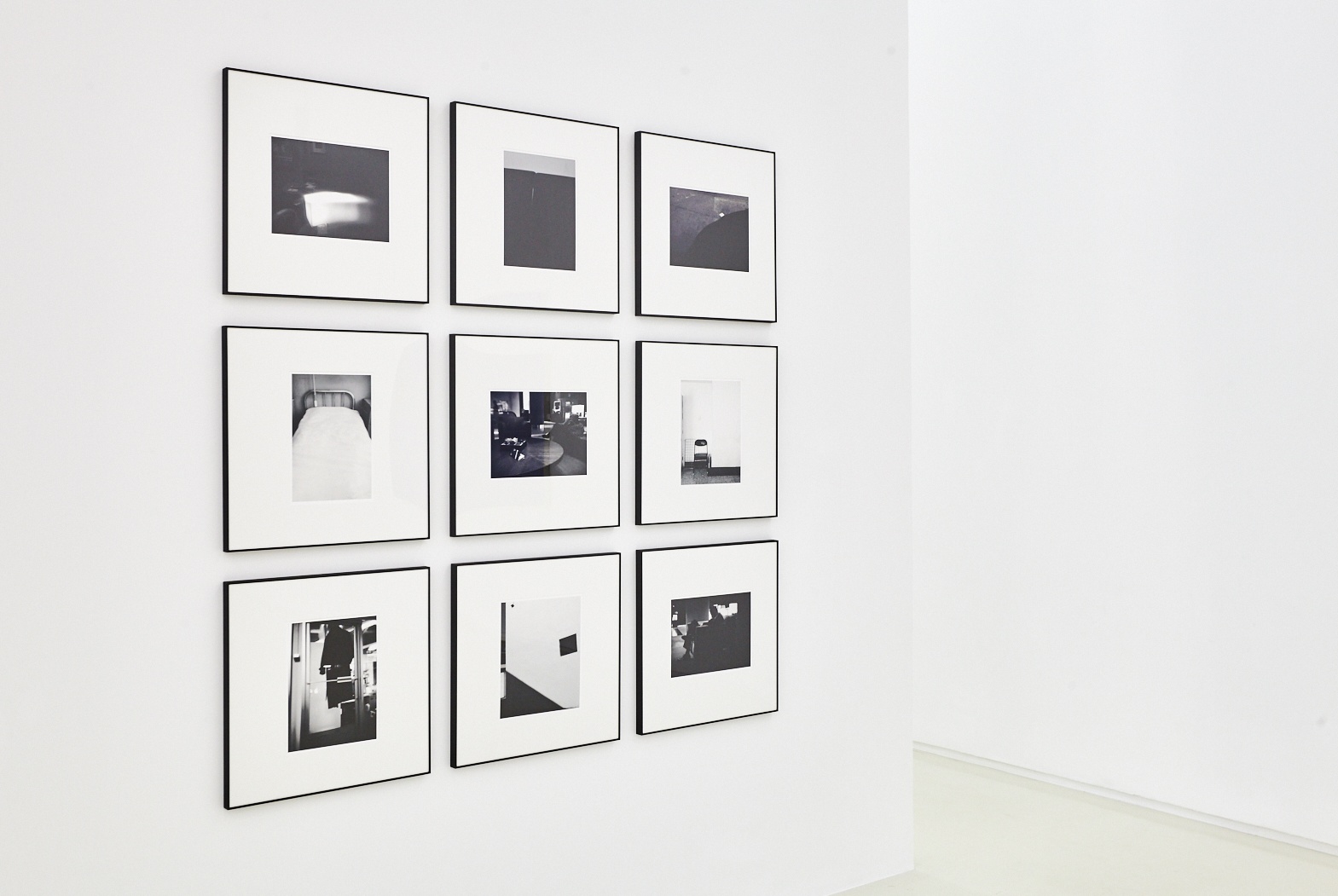
Wang Jian, Untitled, 2011–16, set of 9 Giclée prints, each 22.5 x 30 cm, 30 x 22.5 cm. Photo: Lv Wenzhi.
The psychological reality of an artist immured in his solitude, in the act of looking as part of his practice, is touchingly conveyed in how his works resonate with each other. The photograph Jinze S1 has an air of nonchalance, exhibiting the ability of the artist to be able to observe, to enter into the real sense of things, and distill life into the abstract. It provided the starting point and Jinze H6, the drawing, its realization. The former simmers and suggests, the latter oscillates, deafens and saturates, as if to illustrate that the Rigveda is based on the science of sound.21 The drawing looks as though the marks had been applied in a rage, with charcoal sticks thrown as darts on a blank white support—almost as an act of obliteration—to extinguish its ostensive potential to remain a pristine blank page. The immediacy of clutching the laden charcoal, as if drawing with his fingers, enabled Wang Jian to force down black marks on paper, sometimes smudging, sometimes frantically erasing previous traces, and sometimes reinforcing with a more intense acrylic paint, creating a cataclysmic transition from the original peaceful looking photograph of a corridor. The drawing is ominous and portentous, preserving a sense of an eternal indomitability and an immediacy, an outburst like Jekyll becoming Hyde, an unspeakability, godlessness, and hopelessness that reflects humanity at war with itself. 22
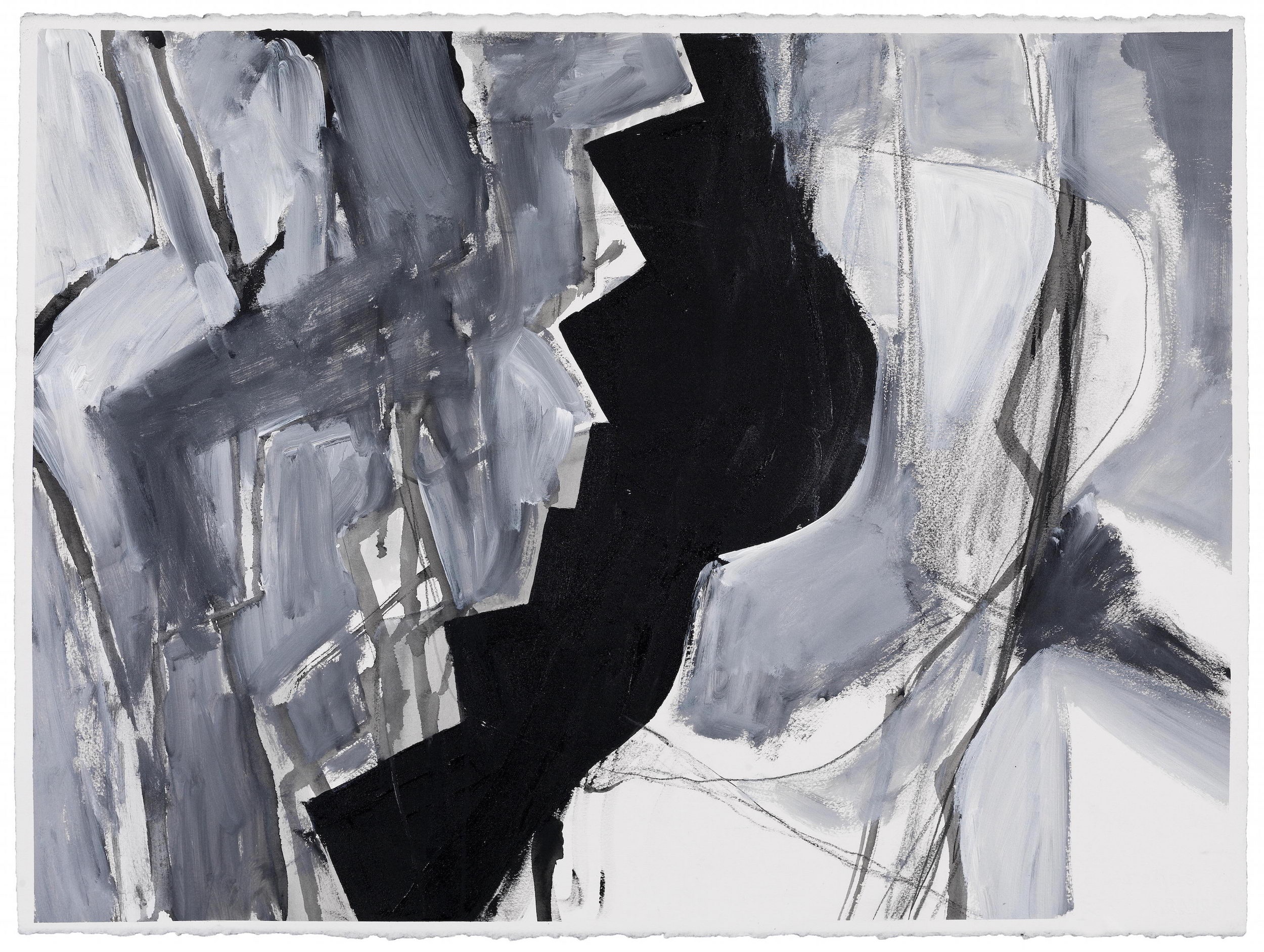
Wang Jian, Jinze H6, 2016, charcoal and acrylic on paper, 55 x 74 cm.
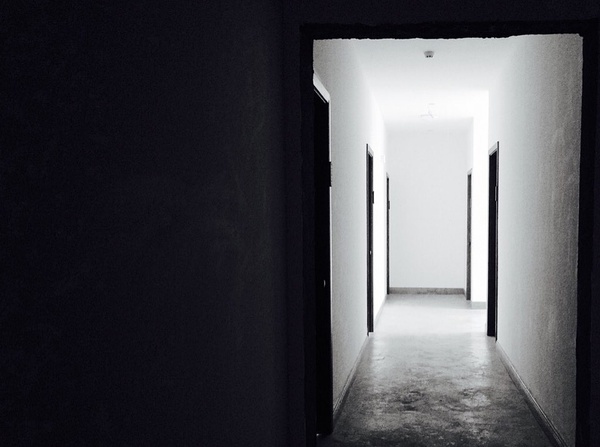 Wang Jian, Jinze S1, 2016, Giclée print, 22.5 x 30 cm.
Wang Jian, Jinze S1, 2016, Giclée print, 22.5 x 30 cm.
As if to leave no room for doubt, a blacker than black acrylic zigzag laceration created in the middle of the space, leads us straight over a precipice into a sheer drop; we are plunged into the void of the “soundless and formless,” as referred to in the Daodejing.23 Nothingness is squeezed out of nothing. We find ourselves in a bottomless well of immense quietude.
This pivotal graveyard of natural and synthetic black residues may have abandoned itself to a transcendent quietness, but it is by no means peaceful. The change through which we have been transported, this change in concrete space, functions not as a mere mental operation, and enables us not just to change place, but also to change our nature.24 The deep void in the central blackness of this drawing, this anxious quiet, corresponds to a sense of inner emptiness to which we have been taken to contemplate, so different from the earlier sense of ecstatic markmaking. There is an immensity expressed through an inner intensity, our inner hidden desert. “Once more emptiness stretched out inside me and I was a desert within a desert, my spirit has left me. The expanse of the spirit is lost in the infinite, uninhabited expanse that is the desolation of earth’s place of solitude.”25
With Jinze H6, the exterior, superficial space of a photograph is transported into the intimate space of the artist’s mind, his travails. Walking the tight rope between nostalgia and void, between ambivalence and guilt, without being seduced by the alchemy of artistic creation, as if once “poetically expressed, the sadness is diminished, and ponderousness lightened,”26Wang Jian’s ambivalence seems like a collision of differing emotions, of spiritual complacency, of succumbing to irrational fears and the death wish of Dostoevsky’s “underground man”27 or nihilistic tendency of Nietzsche. This interstitial space seems surreal and impenetrable.
The unsettling part is that Wang Jian then goes on to forensically exterminate any small morsel or amoebic presence of life and hope. Seemingly observed and executed with a mixture of relative indifference, his photographs, drawings, and paintings are spare, disinterested, and detached. He is presenting to us an understanding of nothingness that corresponds to hopelessness and a chilling indictment of the times he lives in.
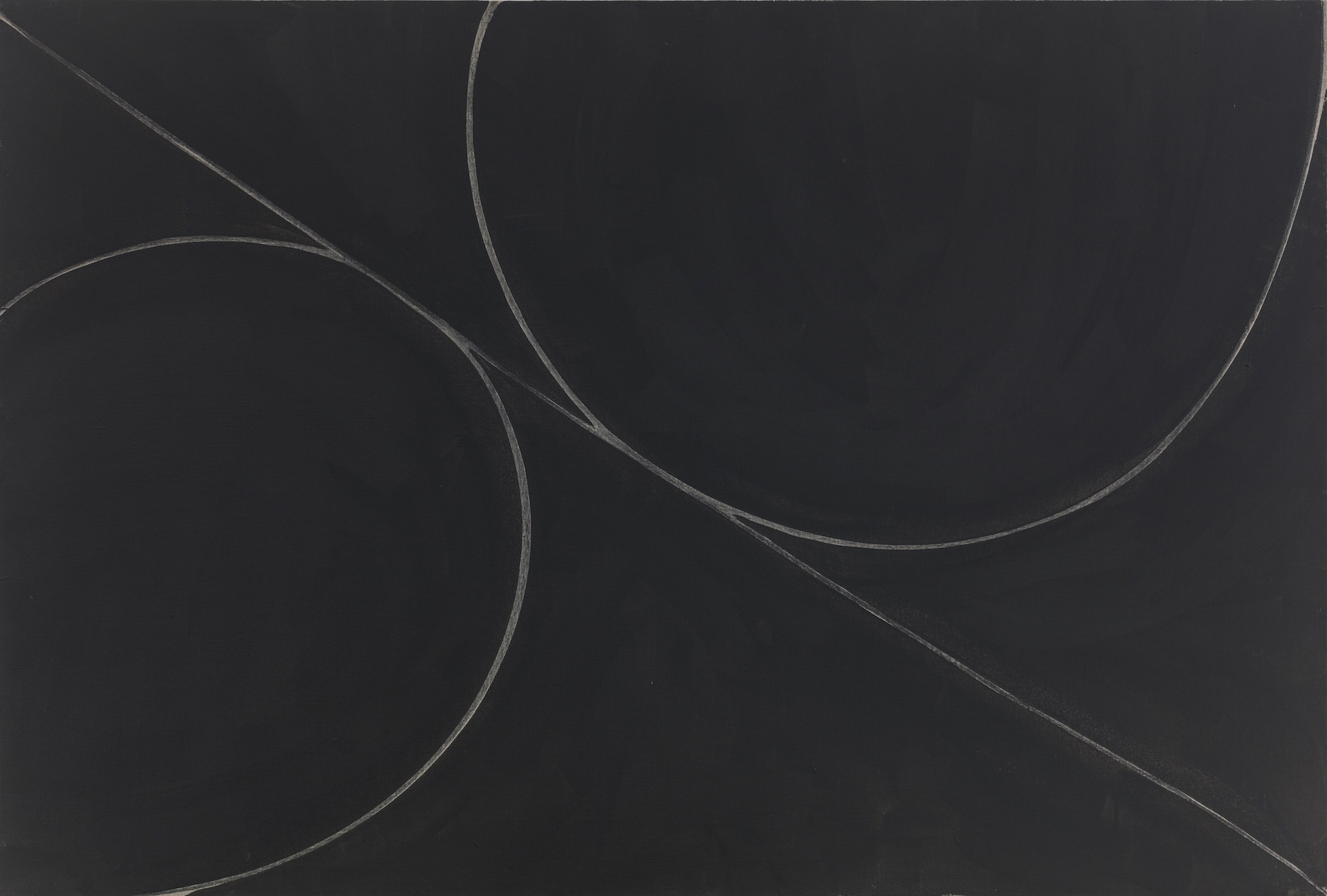 Wang Jian, Jiangnan H2, 2015, Acrylic, ink and charcoal on canvas, 120 x 180 cm.
Wang Jian, Jiangnan H2, 2015, Acrylic, ink and charcoal on canvas, 120 x 180 cm.
In addition to the aftermath of the Cultural Revolution, the idea of globalization and its attendant progress has also made a not inconsiderable contribution to the feeling of ambivalence and futility. Wang Jian’s use of black, fragmented, punctuated, obscured, and silhouetted imagery reflects this global zeitgeist and it is an increasingly common strategy deployed by artists in their engagement of the subject of illegibility and erasure of traumatic events in a period of contemporaneity. This aesthetic of plight and incongruity is thought to locate “an ethics of representation that is predicated. . . . on marking precisely that which cannot be represented, yet making it somehow legible.28 Nowhere is it more poignant than the aesthetics of darkness to emphasize the political illegibility and representational erasure of immigrants and refugees and their bare lives.29 The significant topic of “bare life” also formed a major part of Corey Schultz’s talk at the Making the New World: The Arts of China’s Cultural Revolution conference, where he discussed the “bare precarious life” of the Chinese peasant and migrant figures, holding down “3-D” jobs; that is, dirty, dangerous, and degrading.
Nevertheless, unlike many of his countrymen, Wang Jian has got out of the “warm bath of nostalgia,”30 eluded self-deception, duplicity, to “make(ing) Memory matter,”31 making a Bachelardian new world through making new images, while at the same time submitting to the ancient Chinese saying that “the common man has a share of responsibility in the fate of his country.”32 This attitude is a touching gesture at once of obeisance, resignation, and determination, and, perhaps, part of the cyclical nature of mankind.
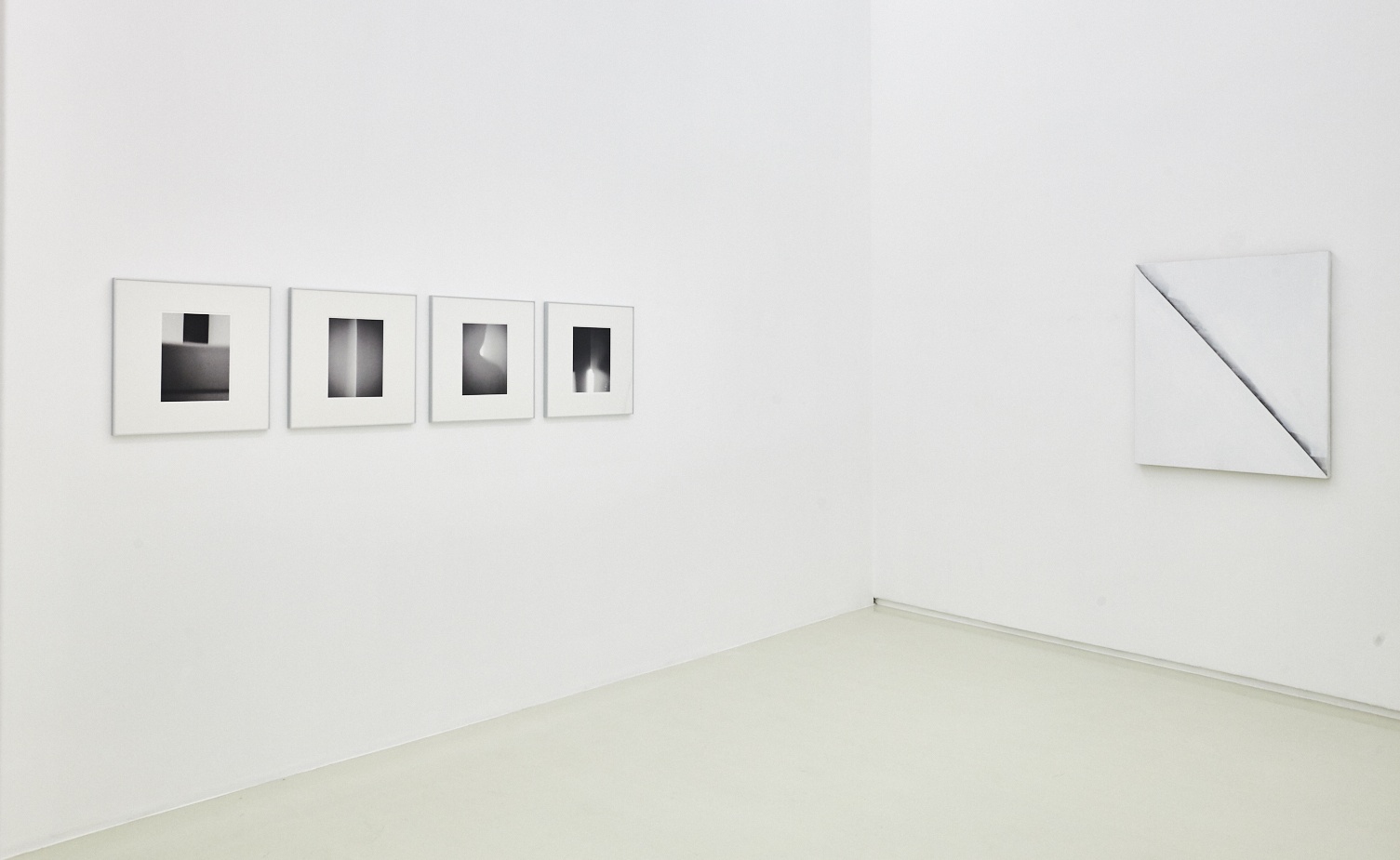
Wang Jian, nothingness was not, 2016, installation view at PIFO Gallery. Photo: Lv Wenzhi.
Notes
1. Kenneth Kramer, World Scriptures: An Introduction to Comparative Religions (New Jersey, USA: Paulist Press, 1986), 129, in Adrian George, “writings on the unwritable,” curator’s statement, http:// pifogallery.bm11.artlogic.net/usr/library/documents/main/writings-on-unwritable-25-sept-final-eng. pdf/. 2. Wang Shilong’s works, such as No. 84 (2009), presented hundreds of undulating lines carefully drawn and then interrupted by a vertical tear. Poétique: The 9th Annual Exhibition of Abstract Art, April 23–June 5, 2016, Pifo Gallery, Beijing, https://www.artsy.net/artwork/wang-shilong-wang-shilong- no-dot-84/.
3. Despite T. S. Eliot’s own disavowal, it is commonly thought by critics that The Waste Land represented “the disillusionment of a generation.” See Eckart Gillen, “How R. B. Kitaj created his Holocaust masterpiece,” Jewish Chronicle Online, March 8, 2013, http://www.thejc.com/arts/artsfeatures/ 103107/how-r-b-kitaj-created-his-holocaust-masterpiece/.
4. Ibid.
5. Ibid.
6. Ibid.
7. Ibid.
8. Ibid.
9. George, “writings on the unwritable.”
10. Gaston Bachelard, The Poetics of Space, trans. M. Jolas (Massachusetts: Beacon Press, 1994 [1964]), 47.
11. George, “writings on the unwritable.”
12. Author William Boyd recounting his interest in and meeting with John Hoyland, “Beautiful Geometry: William Boyd on John Hoyland,” Guardian, October 6, 2015, http://www.johnhoyland.com/testarticle/. 13. Bachelard quotes Jules Valles (L’enfant, 238, French version), who says “L’espace m’a toujours rendu silencieux,” translated into English as “Space has always reduced me to silence.” Bachelard, The Poetics of Space, ch. 8, “Intimate Immensity,”183.
14. Bachelard, The Poetics of Space, 183. Bachelard’s “mark of infinity” is a description of a dreamlike infinity, like a daydream that “contemplates grandeur. . . . ,” “transporting the dreamer outside the immediate world. . . . ”
15. Paul Nash, Exhibit 7, Unseen Landscapes, exhibition leaflet, Paul Nash, Tate Britain, October 26– March 5, 2017.
16. E-mail conversation between author and curator, October 26, 2016.
17. Ibid.
18. Ibid.
19. George, “writings on the unwritable.”
20. Matt Crowley, “Soul Theft through Photography,” Skeptical Briefs 24, no. 1 (Spring 2014), http://www. csicop.org/sb/show/soul_theft_through_photography/.
21. “Sama Veda,” Hindu Universe, http://www.hindunet.org/vedas/samveda/index.htm/.
22. This is perhaps better understood by listening to Paul Nash speak of the ravaged landscapes he depicted as a war artist during the World War I: “It is unspeakable, godless, hopeless. I am no longer an artist interested and curious. I am a messenger who will bring back word from me fighting to those who want the war to last forever. Feeble, inarticulate will be my message, but it will have a bitter truth and may it burn their lousy souls.” Exhibit 2, We are Making a New World, 1918, exhibition leaflet, Paul Nash, Tate Britain, October 26–March 5, 2017.
23. George, “writings on the unwritable.” George quotes this verse from the Daodejing: “[T]here is something undifferentiated and yet complete, that existed before heaven and earth. Soundless and formless, it depends on nothing and does not change," http://www.bbc.co.uk/religion/religions/ taoism/beliefs/tao.shtml/.
24. Bachelard, The Poetics of Space, 206.
25. Bachelard, Ibid., 205. Here Bachelard is quoting Henri Bosco.
26. Bachelard, The Poetics of Space, 201.
27. Marshall Berman, All That Is Solid Melts into Air (London and New York: Verso, 1997 [1982], 219–28. Fyodor Dostoevsky’s Notes from the Underground (1864), is a narration of the “underground man” who, when confronted with the ominous and threatening aspects of modernity, responds with an undefinable passion that is at once arrogant yet fearful, insolent yet apologetic, angry yet sincere.
28. Veronica Tello, Counter-Memorial Aesthetics: Refugees Histories and the Politics of Contemporary Art (London, New York: Bloomsbury, 2016), 125–54. Tello is of the opinion that the artist Dierk Schmidt’s image confronts the viewer with a depth of black that emphasizes the political illegitimacy and invisibility of the vanquished refugees in question, ch. 5: “History Painting, Fiction and Paranoia: Dierk Schmidt’s SIEV-X—On a Case of Intensified Refugee Politics.”
29. The idea of “bare life,” meaning the human stripped of the right to live in human society, has been discussed by critics such as Tello, see Tello, Counter-Memorial Aesthetics: Refugees Histories and the Politics of Contemporary Art, 11, 132, and ch. 5 n. 20, and T. J. Demos, “Life Full of Holes,” Grey Room 24 (Summer, 2006), 72–87.
30. “Cultural Policy for a Heroic Age: The Summary,” Richard King, speaker at Making the New World: The Arts of China’s Cultural Revolution, November 11–12, 2016, Whitechapel Gallery, London.
31. Lisa Saltzman, Making Memory Matter: Strategies of Remembrance in Contemporary Art (Chicago and London: The University of Chicago Press, 2006), 53. Tello, Counter-Memorial Aesthetics: Refugees Histories and the Politics of Contemporary Art, 213, n. 20.
32. Li Zehou, The Path of Beauty: A Study of Chinese Aesthetics, trans. Gong Lizeng (Hong Kong, Oxford, and New York: Oxford University Press, 1994), 158.
